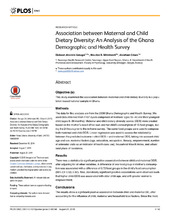Association between maternal and child dietary diversity: An analysis of the Ghana Demographic and Health Survey
Peer reviewed, Journal article
Published version

Åpne
Permanent lenke
https://hdl.handle.net/1956/12045Utgivelsesdato
2015-08-25Metadata
Vis full innførselSamlinger
Originalversjon
https://doi.org/10.1371/journal.pone.0136748Sammendrag
Objective (s). This study examined the association between maternal and child dietary diversity in a population-based national sample in Ghana. Methods. The data for this analysis are from the 2008 Ghana Demographic and Health Survey. We used data obtained from 1187 dyads comprised of mothers’ ages 15–49 and their youngest child (ages 6–36 months). Maternal and child dietary diversity scores (DDS) were created based on the mother’s recall of her own and her child’s consumption of 15 food groups, during the 24 hours prior to the in-home survey. The same food groups were used to compose both maternal and child DDS. Linear regression was used to assess the relationship between the predicted outcome – child DDS -- and maternal DDS, taking into account child age and sex, maternal factors (age, education, occupation, literacy, empowerment, number of antenatal visits as an indicator of health care use), household Wealth Index, and urban/rural place of residence. Results. There was a statistically significant positive association between child and maternal DDS, after adjusting for all other variables. A difference of one food group in mother’s consumption was associated with a difference of 0.72 food groups in the child’s food consumption (95% CI: 0.63, 0.82). Also, statistically significant positive associations were observed such that higher child DDS was associated with older child age, and with greater women’s empowerment. Conclusions. The results show a significant positive association between child and maternal DD, after accounting for the influence of child, maternal and household level factors. Since the likely path of influence is that maternal DDS impacts child DDS, public health efforts to improve child health may be strengthened by promoting maternal DDS due to its potential for a widened effect on the entire family.
